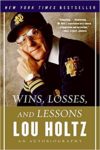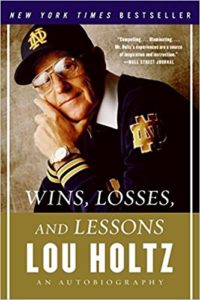It is a simple question… “What’s Important Now?” It is also a powerful tool for shaping / programming / improving your thinking to achieve your highest priority goals.
 The W.I.N. approach has been used by legendary coaches such as football’s Lou Holtz and the NBA’s Pat Riley. Lou Holtz asked his players to ask themselves the W.I.N. question 25-35 times per day so they would keep themselves on track with the most important goals or activities they had as college football players and students.
The W.I.N. approach has been used by legendary coaches such as football’s Lou Holtz and the NBA’s Pat Riley. Lou Holtz asked his players to ask themselves the W.I.N. question 25-35 times per day so they would keep themselves on track with the most important goals or activities they had as college football players and students.
Why does W.I.N. work?
“What’s Important Now?” forces your mind to consider your priorities and TAKE Action on them. Once you decide something is important, each time you ask yourself the W.I.N. question, you are reminded that NOW is the time to take action and move in the direction of your goal!
The other reason it works is the fact that “What we focus on increases”. If we focus on the negative things happening in our lives, we see more negatives. By focusing on the positives, we see that there are more good things going on than we may have thought. When you focus on your priorities and goals, you begin to see opportunities and new ways to achieve them. So why don’t we focus on the positives?
Left to itself, the mind runs whatever programs it has accumulated over the years. Unfortunately for many of us, there are plenty of self-defeating programs running around in our heads telling us things such as “you aren’t good enough”, “I’m not ready” or “Tomorrow would be a better time to start”. The “What’s Important Now” question short circuits that thinking and makes us focus on ONE thing… the most important thing. In many ways it simply bypasses our negative programming.
“What’s important now”
also tricks your mind
The other way that the W.I.N. question tricks your mind is that it automatically breaks down your biggest goals into smaller bite-sized actions or steps that you can take NOW. It is about doing something in the present rather than trying to make the huge jump into an ideal future. The “mind trick” occurs when, before you know it, you have either achieved your highest priority (and need to set a new one) or you look up and find that you are about to achieve it. By asking “What’s Important Now” on a regular basis, many times per day, you are training your brain to move toward achieving your highest priority. You are also putting blinders on so that you are not distracted by lower priority activities.
The REAL question is …
Now that you have learned about it, are you going to W.I.N.? Do you know “What’s Important Now”… for you? How are you going to put this idea to work for your life?
Please leave a comment below and tell us your plan or, better yet, tell us how the “What’s Important Now?” question has worked for you! Isn’t your life important enough to apply this powerful tool?




